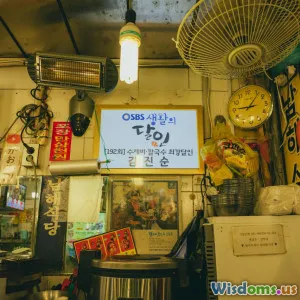
Why Cooking Competitions Became Primetime TV Gold
14 min read Discover why cooking competitions have dominated primetime TV, unraveling their appeal, influence, and cultural significance in the modern entertainment landscape. (0 Reviews)
Why Cooking Competitions Became Primetime TV Gold
Introduction: Sizzling Entertainment, Served Hot
Around dinner tables worldwide, families, foodies, and casual viewers have traded sit-coms and reality dramas for the high-stakes, high-flavor thrills of cooking competitions. Imagine flames leaping from stoves, the clock ticking down, and a chef’s trembling hands delivering a final, elaborate plated masterpiece—seconds before a celebrity judge’s raised eyebrow decides their fate. What is it about these culinary face-offs that has transformed them into primetime television sensations, as mouthwatering in ratings as they are on-screen?
Since the first spatula-wielding contests hit airwaves, the genre has evolved from mere skill battles into massive cultural phenomena. This article unpacks the irresistible recipe that launched cooking competitions to TV superstardom—examining their origins, secret ingredients for audience captivation, and the wider impact they’ve left on food culture and entertainment itself.
The Origins: From Esoteric to Electric
The Humble Beginnings
Cooking on television isn’t new. Julia Child’s groundbreaking show, The French Chef, debuted on PBS in 1963, demystifying French cuisine while endearing her to millions. Early food TV was educational and instructional. The competition aspect arrived later, blending expertise with drama. Historic programs like Japan’s Iron Chef (premiered 1993) showcased culinary skill under unforgiving time limits—turning chefs into rockstars. According to The New York Times, Iron Chef was the first to combine theatrics, mystery ingredients, and a gladiatorial spirit, laying the foundation for what would explode into a global TV phenomenon.
The Reality TV Revolution
The rise of reality TV in the late 1990s triggered a transformation in how audiences consumed both food and competition. Endemol’s Big Brother and Survivor primed viewers for ordinary people in extraordinary circumstances. Food Network’s Chopped (debut: 2009) and Fox’s MasterChef (U.S. debut: 2010) borrowed mechanics from unscripted reality TV but layered in culinary artistry. This melting pot of competition, emotion, and personal stories catapulted cooking shows to the front of the pack.
The Core Ingredients of Primetime Success
1. Relatable, Diverse Contestants
Audiences quickly fell in love with competitions that weren’t just a showcase for professional chefs. Amateurs, home cooks, and diverse cultural perspectives brought open accessibility and heart to the kitchen arena. On MasterChef, 13-year-old prodigies and retirees alike chase dreams, while shows like The Great British Bake Off champion inclusivity—with contestants of all ages, backgrounds, and abilities. These faces are familiar, reflective, and aspirational, allowing viewers to see themselves on-screen.
“Everyone has to eat. Food is universal—so are heart, nerves, and triumph.” – Mary Berry, Judge, The Great British Bake Off
2. The Drama of the Kitchen
Great competitions are defined by tension, stakes, and stories. Cooking shows double down: a missed ingredient, burnt sauce, or snapped piping bag turns a recipe into riveting theater. The timed pressure, secret twists, frenzied teamwork, and instant critiques ignite true drama—comparable to playoff sports. In Hell’s Kitchen, Gordon Ramsay’s famous tirades have become pop-culture memes, emphasizing that triumph and disaster are just one slip away.
Data reinforces this: a Nielsen study (2022) found over 43% of global viewers preferred reality-based competition shows that emphasized “authentic adversity and real reactions.” Food competitions deliver this in spades, intermixed with genuine transformation and cathartic success.
3. Food as Visceral Spectacle
Modern TV is built on hyper-visual appeal. Nowhere is this clearer than in cooking competitions. Directors deploy macro cameras, slow-motion shots, and lush color grading to turn ganache drips or sous-vide steaks into visual poetry. Appetite, artistry, and escapism combine as viewers are transported into a sensory world—so much so that Instagram hashtags #foodporn or #nailedit consistently trend during and after airings. MIT Media Lab even found that television programs featuring food increase at-home social media posts about cooking by nearly 30% during and after broadcast.
4. Storytelling and Vulnerability
Interwoven with each episode are stories of family heritage, hard-won sacrifice, and hope. Contestants reveal kitchen mishaps as metaphors for life, sharing details like overcoming adversity or pursuing immigrant dreams. Viewers connect emotionally, adopting favorite ‘characters’ and investing in story arcs across seasons. Top Chef winner Kristen Kish described her experience:
“The show isn’t just about plates—it’s about the stories of who we are, where we come from.”
5. Judges: Part Critic, Part Celebrity
Cooking competition judges are culinary maestros, TV personalities, and often social commentators. With charisma, wit, and palate-proof authority, icons like Gordon Ramsay, Padma Lakshmi, and Paul Hollywood have become brands unto themselves. Their formative power is felt beyond TV: 2019 saw more than 200,000 visitors at The Great British Bake Off live events in London alone—a testament to judge-driven fandoms.
The Evolution: How Cooking Shows Reshaped Entertainment
Democratizing Gourmet Dreams
Once the domain of fine-dining culinary insiders, cooking competitions unlocked the doors to high cuisine. Amateur cooks on MasterChef regularly produce restaurant-worthy dishes—shattering myths that only professionals belong in gourmet kitchens. Aspiration meets relatability. This ethos is mirrored by rising enrollment figures at culinary schools: The American Culinary Federation reported a 22% increase in applications from 2011 to 2017, paralleling the ‘foodie boom’ on television.
Turning Home Chefs Into Heroes
Cooking competitions uncovered hidden talents and spawned overnight revelations. Nadiya Hussain’s victory on Bake Off (2015) transformed her into an icon—not just for her bakes, but as a British Muslim role model. Christine Ha, blind chef and MasterChef season three winner, inspired millions: “If I can do this, anyone can.” Their successes prove food is a platform for underdog narratives and societal change, seeding inspiration for countless home-cooked ambitions.
Fostering Food Literacy
With television as its classroom, the competitive format teaches audiences new techniques, ingredient origins, and global cuisines. During Top Chef: Kentucky (2019), viewers watched expert butchery and bourbon-pairing—a unique, entertaining form of culinary education. Nielsen analytics (2021) showed a 35% uptick in Google searches for “how to make” recipes within 24 hours after major cooking contest finales, proving passive entertainment often sparks active learning and exploration in kitchens worldwide.
Cultural Impact: Shaping Trends and Palates
Mainstreaming Multicultural Cuisines
The repertoire on TV is richly multicultural—as much about kimchi pancakes, babka, or Peruvian ceviche as classic French soufflé. By spotlighting diverse foods and stories, these competitions have contributed to growing mainstream acceptance and curiosity toward global cuisine. Kroger retail data (2022) reflected a 17% sales increase in international food categories following the airing of culturally themed cooking challenges.
Instagram, Streaming, and Foodie Culture
Cooking competitions also spark trends off-screen. Iconic challenges ignite social media: think the viral “mirror glaze cake” from Bake Off or intricate dumpling folds from MasterChef. The dual-screen era primes viewers to recreate, hashtag, and share—as #GBBO racks up billions of social impressions per season.
Streaming giants have waded in as well. Netflix originals such as Nailed It!, The Final Table, and Chef’s Table: Pizza have democratized access, catering to binge-watchers and global viewers. In 2021, Nailed It! cracked the top ten most-streamed reality TV shows in the US, according to Parrot Analytics—itself proof that the genre has mass, on-demand draw within and beyond prime viewing hours.
Economic Ripples in the Food Industry
The popularity of cooking competitions has created ripple effects throughout the food industry. Product lines from Top Chef alumni, MasterChef branded cookware, and even judge-endorsed spice collections have sprouted in retail aisles. A survey by The Harris Poll (2023) found that nearly 42% of adults aged 18–49 purchased a kitchen gadget or cookbook inspired by a TV chef/judge within the last 12 months—indicative of huge, measurable commercial influence.
The Global Recipe: Local Flavors, Universal Appeal
Format Flexibility
While the formula is familiar, the flavor is local. In the UK, The Great British Bake Off punches up kindness and cozy camaraderie. In the US, Hell’s Kitchen leans into verbal pyrotechnics. India’s MasterChef features family-style teamwork, and Australia’s version is famed for its nurturing, inclusive approach. The adaptation and localization of formats demonstrate that the cooking competition’s core—passion, food, striving—translates across borders.
The Pandemic Surge
COVID-19 cemented the genre’s primetime magic. Lockdowns saw TV viewership surge, and for many, food competitions became solidarity-driven appointment viewing—and even personal lifelines. Food delivery services reported a spike in orders for dishes featured in recent episode challenges, while social platforms filled with attempts at recreations and home kitchen fails. The craving for comfort, inspiration, and connection—amidst isolation—only anchored the shows’ role as essential, joyful distractions.
Behind the Scenes: What Keeps It Fresh?
Constant Reinvention
To avoid staleness, producers innovate relentlessly—new twists on ingredients (Chopped mystery baskets), international or childhood theme weeks, cross-genre celebrity guest episodes, or real-time audience voting. This dynamic creativity ensures the format remains addictive and tantalizes both viewers and returning contestants, seasoning each episode with unpredictability.
The Explosion of Niche Subgenres
While big-name shows dominate, niche spin-offs thrive: Kids Baking Championship, The Great British Sewing Bee (inspired by the baking original), and vegan or plant-based competitions highlight emerging tastes, celebrating inclusivity and specialization far beyond the kitchen.
Conclusion: Why They Endure—And What’s Next
From modest beginnings to international gold, cooking competitions have stitched themselves immovably into our primetime tapestry. Their genius isn’t just in showmanship or seasoning, but in using the act of cooking—a truly universal art—as a vehicle for storytelling, challenge, community, and the joy of possibility.
As streaming reshapes habits and new culinary stars rise from home kitchens to Hollywood, the genre’s core appeal will remain: the honest, universal risk of trying, failing, and occasionally triumphing in front of millions.
So the next time you tune in, remember—you’re not just watching people cook. You’re cheering for every dream, every nerve, and maybe imagining your own winning dish, too.
Further Reading
- Allen Salkin, From Scratch: Inside the Food Network
- Krishnendu Ray, The Ethnic Restaurateur
- “Food Competitions as Entertainment: How TV Changed the Way We Cook”, MIT Media Lab, 2021
Rate the Post
User Reviews
Popular Posts


















